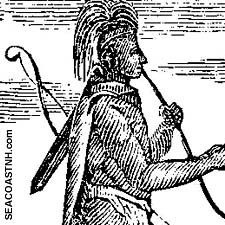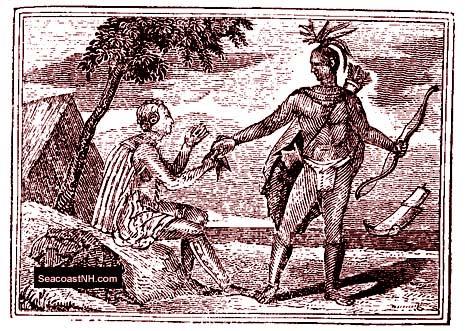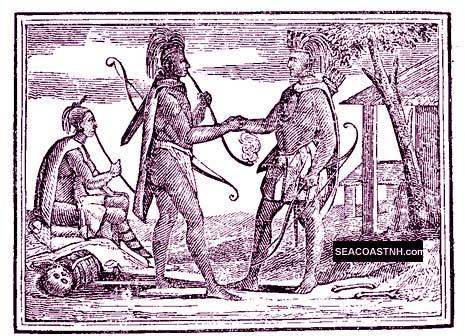|
FRESH STUFF DAILY |
|
|
||
|
|
||
|
|
||
|
SEE ALL SIGNED BOOKS by J. Dennis Robinson click here |
||
With few facts to flesh out their story, Native Americans have become largely invisible in early NH history. They appear largely in stories about Indian raids on white settlements at the turn of the 18th century. But a much deeper and detailed study is needed.
EDITOR'S NOTE: This essay is adapted from a history of Portsmouth and Strawbery Banke now in development. SEE ALSO: Passaconaway Most accounts of early Portsmouth scarcely mention its original settlers at all. Thousands of years of Native American occupation are reduced to a sentence or two. Often the only references are to Indian raids on white settlers during King Phillips war late in the 1600s when French soldiers fighting the British helped stir up Native rebellion. With almost no documentation of Indian life here before English occupation, we have to look for evidence elsewhere. When Captain John Walker explored Maine’s Penobscot River in 1579, he reported seeing Native Americans there. But the first detailed eye witness account from an Englishman first visiting this region comes from Bartholomew Gosnold who examined the coast from Maine to Massachusetts in 1602. The meeting did not go as you might expect.
Spotting eight men in a "Biscay shallop with sail and oars" probably near what is now Cape Ann, Gosnold at first thought they were European fishermen in distress. It was only when the party of Indians came aboard ship that he realized who they were. One man in the group of Natives wore "Christian" clothing including a black waistcoat, breeches, shoes, stockings and a hat with a band. The rest were naked except for short pants made from seal skin and deerskins thrown loosely about their shoulders. The Indians gave a lengthy speech using some "Christian words" and drew Gosnold a map of the area using a piece of chalk. In memory of this initial close encounter with an obviously intelligent and adaptable new race, Gosnold named the location of the meeting "Savage Rock". Native Americans, despite their obviously sophisticated culture would remain "savages" and "heathens" to many New England historians through the next three centuries. Their story remains largely untold to this day. Martin Pring, who had traveled with Gosnold, was the first known European explorer to document a trip 10 or 12 miles up the Piscataqua River in 1603. "In all these places," Pring reported, "we found no people, but signes of fires where they had been." CONTINUE INDIAN ESSAY Native Americans in Early NH The fact that Native Americans were rarely reported in the Portsmouth area and did not attack and destroy the first European outposts here is sometimes seen as evidence that Indians were never here at all. Prehistoric Portsmouth is often depicted as an empty landscape frozen in time. Well into the 20th century local historians imagined an unpopulated and lush region along a breathtaking and swift river waiting only to be discovered by white explorers. We can be certain that Native Americans populated New Hampshire’s coast, rivers, lakes, forests and hills for 12,000 years or more before European settlers changed everything. The oldest Native American occupation sites discovered on New Hampshire’s coast are in Seabrook and date to a little over 4000 years ago. Evidence shows that they were successfully hunting swordfish on the open sea at this time, along with many other species. Earlier than this the coastal sites are submerged below rising sea level. A mastodon tusk recently dredged up by a fisherman off the coast of Maine attests to this fact. And archeologists have ample evidence of Native American presence on the nearby streams and rivers, back from the ocean.
A paleoindian site discovered just across the Piscataqua from Portsmouth in Eliot, Maine included artifacts dated to at least 10,000 years old. Archeological evidence from the last 3,000 years proves that early Native Americans in this region were adept at building oversized ocean-going canoes. Piles of shells or "kitchen middens" discarded by coastal Natives are more abundant after about 3000 years ago because sea level rose more slowly and the coastline looked more like it does today. Analysis of these trash heaps shows abundant bone remains of large cod among the many fish remains, in addition to seal and terrestrial mammals. They fished with great success using bone hooks and elaborate fishing weirs or nets strung across the rivers on poles. They ate scallops, clams, oysters and lobsters found along the shore in the summer, then moved inland to hunt and trap birds and mammals living in the dense local forests. About 1000 years ago corn, beans and squash were introduced and the people met by the first Europeans were agriculturists. They cleared great areas of trees for farming and foraged and thrived through thousands of brutal New England winters. Speculation about prehistoric life along the seacoast is made more difficult by the fact that the boundaries have changed significantly as the water level rose over millennia, pushing back the coastline and leaving the evidence of former civilizations under water. If Indians were scarce in the founding days at Portsmouth, they had good reasons. Historians estimate that as much as 80 to 90 percent of the local Native population died of exposure to smallpox and other diseases carried by European visitors at the beginning of the 17th century. This "Great Plague" from 1616 to 1619 certainly decimated Piscataqua Natives as well in the years just prior to European settlement here. A few years later, in 1633, another wave of disease swept through the region. A rare reference in the local record notes that the infection came to Pascataquak "where all the Indians (except one or two) died". Surviving members of local tribes were in no shape for war and understandably wary of all white visitors. Many tribes reportedly gathered in a loose confederation under the leader known as Passconaway. Whether Passaconaway had a spiritual vision, as white histories imply, or whether he avoided attacking New Hampshire first settlers for political and economic reasons is unknown. Either way, for the first half of the 17th century, with very few exceptions, peace reigned. It was a purposeful and organized peace. Indians were canny traders and politicians who valued English, French and Spanish trade goods. They feared the power of European weapons and sometimes tried to ally themselves with whites who might provide protection from other tribes. But the English were not easily trusted. Captain John Walker, the first Englishman to spot Maine natives, stole 300 moose hides from an Indian camp. Early explorers frequently kidnapped Indians to use as guides or sold them into slavery in the West Indies. We only have to turn to the record of the Pilgrim colony a Plymouth to understand why Natives feared settlers. Miles Standish, the soldier employed to protect the colony, once stabbed a tribal leader to death during a dinner meeting. Legend says that David Thomson, the first New Hampshire settler, kept a Native American slave in 1623. Fifty years later, George Walton of New Castle had two Indian slaves, as did his neighbor. Archeologists have yet to discover a major pre-colonial Native campsite in Portsmouth. English colonists tended to establish their colonies on top of former Indian settlements. Maybe that happened in Portsmouth, or perhaps the rocky area along the swift river near modern Prescott Park was not considered prime real estate by Natives. Early New Hampshire Indians visited the seacoast seasonally, but preferred the falls of rivers further inland when the fish were plentiful and moved inland for the winter. Assuming Piscataqua area Indians followed the patterns of tribal groups in nearby Maine, they too had begun moving to a more agrarian lifestyle with the introduction of corn, bean and squash crops to this area as late as 1300 to 1400 AD. This more stationary lifestyle, at least in southern Maine, means Indians had more well-defined village designs and a more sophisticated view of land ownership and property boundaries than historians have traditionally credited them with. Native women may have been more involved in Native government and clearly understood the treaties and sale of lands. Indeed, the more studies delve into the complex lives of local Natives during the "Contact Era", the more ridiculous the traditional view of New England’s "savage" people becomes, especially when compared to the "civilized" lifestyle imported from England. New Hampshire’s indigenous people left little evidence behind as they traveled the natural river highways of the Piscataqua. The rivers they named, adopted by English settlers, are often the only evidence of their long and wide-ranging occupation. As fur trading faded along the rivers, white settlements sprung up at the same rocky falls where the Indians had fished for millennia, driving them to more distant hunting grounds. By the last of the Indian raids in the early 1700s, most Indians living in this region had moved north, often settling in Canada. As dams and towns and water-powered sawmills grew up along rivers, the fragile evidence of the "people of the Dawnland" was rapidly obliterated. By 1713, the first "Treaty of Portsmouth" created an untenable list of demands on Natives that further reduced their rights and freedoms. A final snapshot of Native Americans here comes from Rambles About Portsmouth by Charles Brewster. Here Thomas Pickering confronts two Indians in town around the time of the American Revolution: "One day two peaceable Indians came into his residence near the mill. He entered the door, went to the yard -- his mother knowing what was coming, bade them run for their lives. They ran up Water street [now Marcy], with the Captain in full pursuit. Finding he could not gain upon them, when near the South Church hill he threw his axe, which passed between them, the handle touching one of their shoulders." Copyright © 2007 by J. Dennis Robinson. All rights reserved. This article is adapted from his upcoming history of Strawbery Banke Museum scheduled for publication late this year. Please visit these SeacoastNH.com ad partners.
News about Portsmouth from Fosters.com |
| Thursday, April 25, 2024 |


|
Copyright ® 1996-2020 SeacoastNH.com. All rights reserved. Privacy Statement
Site maintained by ad-cetera graphics

 Smuttynose Murders
Smuttynose Murders





















